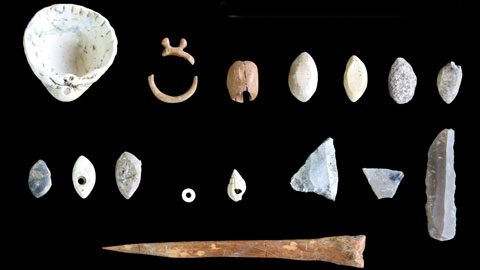Neolithic jewellery workshop discovered at La Draga

30/07/2014
This year's archaeological dig campaign at the La Draga Neolithic Park, located in Banyoles (Pla de l'Estany), will end on Friday 1 August. The campaign lasted two months and gave researchers the chance to complete the dig in Sector A. Sector A is made up of a total surface area of 84 m2 and is located directly next to the site which was excavated in the 1990s, when researchers first began to work on this site.
The sector corresponds to the area the inhabitants of La Draga set up to carry out daily life activities. Among the remains documented were several pits which were used as dumping sites; several archaeological remains were recovered from the inside of these pits. The remains correspond to meals and residue from the different activities the inhabitants carried out.
Worth highlighting is the amount and diversity of personal adornment objects; there are a large number of necklaces made with shells, bones and stones, rings made of bone and necklaces and bracelets made of marble. Many of these remains were found unfinished.
It is possible that they were discarded after being broken at some point in the creation process. This information verifies the existence of a workshop in La Draga dedicated to manufacturing these decorative elements, made both with shells from the seaside, located at some 35 kilometres from the site, and with bones and stones. Tools used in making the objects were also found and this will help researchers recreate the manufacturing processes.
The discovery of a Neolithic jewellery workshop is unusual to the Peninsular Neolithic, and this fact once again places the La Draga as a reference site for the study of the first farming communities of the Western Mediterranean. The Neolithic jewellery pieces, as the jewellery of today's society, are elements of great ideological value. The fact that they were discovered at La Draga makes researchers assume that during the first Neolithic era, some 7,000 years ago, these groups of people wore elements of distinction and of great ideological value.
The excavation also yielded several elements made from wood (70) which correspond to the pillars of cabins, which are the only cabins known to have existed on the Iberian Peninsula in prehistory. The wooden elements belong to the extremes of the oak trunks used as support elements in the construction of wooden structures.
As usual, the dig was conducted under the leadership of the County Archaeological Museum of Banyoles, with the participation of the Universitat Autònoma de Barcelona, the Spanish National Research Council ((IMF, Barcelona) and the Archaeological Museum of Catalonia. Throughout the campaign, numerous experts from these institutions participated in the excavations and studies, as well as some 60 students from the Universitat Autònoma de Barcelona's bachelor's degree in Archaeology and master's degree in Prehistory, Antiquity and the Middle Ages.
The archaeological digs at this important Neolithic site have continued uninterruptedly since 1990. This year, the research group in charge of the project studying La Draga and the first farming communities in Catalonia received funding from the Department of Culture of the Government of Catalonia for a new research project for the 2014-2017 period.